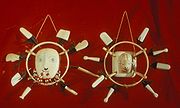
Masks among Eskimo peoples
Encyclopedia

Driftwood
Driftwood is wood that has been washed onto a shore or beach of a sea or river by the action of winds, tides, waves or man. It is a form of marine debris or tidewrack....
, animal skins, bones and feathers. They were often painted using bright colors. There are archeological miniature maskettes made of walrus ivory
Walrus ivory
Walrus tusk ivory comes from two modified upper canines. The tusks of a Pacific walrus may attain a length of one meter. Walrus teeth are also commercially carved and traded. The average walrus tooth has a rounded, irregular peg shape and is approximately 5cm in length.The tip of a walrus tusk has...
, coming from early Paleo-Eskimo
Paleo-Eskimo
The Paleo-Eskimo were the peoples who inhabited the Arctic region from Chukotka in present-day Russia across North America to Greenland prior to the rise of the modern Inuit and/or Eskimo and related cultures...
and from early Dorset culture
Dorset culture
The Dorset culture was a Paleo-Eskimo culture that preceded the Inuit culture in Arctic North America. It has been defined as having four phases, with distinct technology related to the people's hunting and tool making...
period.
Despite some similarities in the cultures of the Eskimo peoples, their cultural diversity makes it hard to generalise how Eskimo
Eskimo
Eskimos or Inuit–Yupik peoples are indigenous peoples who have traditionally inhabited the circumpolar region from eastern Siberia , across Alaska , Canada, and Greenland....
s and Inuit
Inuit
The Inuit are a group of culturally similar indigenous peoples inhabiting the Arctic regions of Canada , Denmark , Russia and the United States . Inuit means “the people” in the Inuktitut language...
used masks. The sustenance, mythology
Inuit mythology
Inuit mythology has many similarities to the religions of other polar regions. Inuit traditional religious practices could be very briefly summarised as a form of shamanism based on animist principles....
, soul concepts, even the language of the different communities were often very different.
Early masks
Archeological masks have been found from early Paleo-Eskimo and from early Dorset culture period. It is believed that these masks served several functions including being used in rituals representing animals in personalized form; being used by shaman in ceremonies relating to spirits (as in the case of a wooden mask from southwestern AlaskaAlaska
Alaska is the largest state in the United States by area. It is situated in the northwest extremity of the North American continent, with Canada to the east, the Arctic Ocean to the north, and the Pacific Ocean to the west and south, with Russia further west across the Bering Strait...
).; it is also suggested that they could be worn during song contest ceremonials;
Associated beliefs

Soul dualism
Soul dualism or a dualistic soul concept is a range of beliefs that a person has two kinds of souls. In many cases, one of the souls is associated with body functions and the other one can leave the body . Sometimes the plethora of soul types can be even more complex...
) that linked living humans, their ancestors, and their prey. Besides synchronical beliefs, there were also notions of unity between human and animal, and myths about an ancient time when the animal could take on human form at will. Traditional transformation masks reflected this unity. Ritual ceremonies could enable the community to enact these stories with the help of masks, sometimes with the masked person representing the animal.
Yup'ik masks

Note
Eskimo groups comprise a huge area stretching from Siberia through Alaska and Northern CanadaNorthern Canada
Northern Canada, colloquially the North, is the vast northernmost region of Canada variously defined by geography and politics. Politically, the term refers to the three territories of Canada: Yukon, Northwest Territories, and Nunavut...
(including Nunatsiavut
Nunatsiavut
Nunatsiavut is an autonomous area claimed by the Inuit in Newfoundland and Labrador, Canada. The settlement area includes territory in Labrador extending to the Quebec border. In 2002, the Labrador Inuit Association submitted a proposal for limited autonomy to the government of Newfoundland and...
in Labrador
Labrador
Labrador is the distinct, northerly region of the Canadian province of Newfoundland and Labrador. It comprises the mainland portion of the province, separated from the island of Newfoundland by the Strait of Belle Isle...
and Nunavik
Nunavik
Nunavik comprises the northern third of the province of Quebec, Canada. Covering a land area of 443,684.71 km² north of the 55th parallel, it is the homeland of the Inuit of Quebec...
in Quebec
Quebec
Quebec or is a province in east-central Canada. It is the only Canadian province with a predominantly French-speaking population and the only one whose sole official language is French at the provincial level....
) to Greenland
Greenland
Greenland is an autonomous country within the Kingdom of Denmark, located between the Arctic and Atlantic Oceans, east of the Canadian Arctic Archipelago. Though physiographically a part of the continent of North America, Greenland has been politically and culturally associated with Europe for...
. The term Eskimo has fallen out of favour in Canada and Greenland, where it is considered pejorative
Pejorative
Pejoratives , including name slurs, are words or grammatical forms that connote negativity and express contempt or distaste. A term can be regarded as pejorative in some social groups but not in others, e.g., hacker is a term used for computer criminals as well as quick and clever computer experts...
and the term Inuit has become more common. However, Eskimo is still considered acceptable among Alaska Natives
Alaska Natives
Alaska Natives are the indigenous peoples of Alaska. They include: Aleut, Inuit, Tlingit, Haida, Tsimshian, Eyak, and a number of Northern Athabaskan cultures.-History:In 1912 the Alaska Native Brotherhood was founded...
of Yupik and Inupiat (Inuit) heritage, and is preferred over Inuit as a collective reference.

